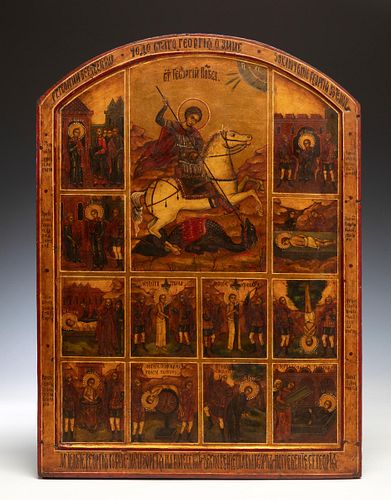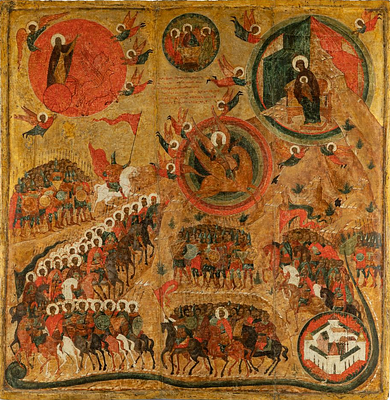Russian school, workshops of the Old Believers, 18th-19th cent. 18TH-19TH C. "San Jorge slaying the dragon and twelve hagiographic scenes". Tempera, g
Lot 27
About Seller
Setdart Auction House
Carrer Aragó 346
Barcelona
Spain
Setdart Subastas was born in 2004 and is currently the first online art auction in Spain with solidity, prestige and reliability guaranteed by our more than 60,000 users. Setdart has a young, dynamic and enterprising team ready to successfully manage the purchase and sale of art works through custom...Read more
Estimate:
EUR€4,000 - EUR€5,000
$4,166.67 - $5,208.33
Absentee vs Live bid
Two ways to bid:
- Leave a max absentee bid and the platform will bid on your behalf up to your maximum bid during the live auction.
- Bid live during the auction and your bids will be submitted real-time to the auctioneer.
Bid Increments
| Price | Bid Increment |
|---|---|
| EUR€0 | EUR€10 |
| EUR€200 | EUR€25 |
| EUR€500 | EUR€50 |
| EUR€1,000 | EUR€100 |
| EUR€3,000 | EUR€200 |
| EUR€5,000 | EUR€500 |
| EUR€10,000 | EUR€1,000 |
| EUR€20,000 | EUR€2,000 |
| EUR€50,000 | EUR€5,000 |
About Auction
By Setdart Auction House
Sep 23, 2021
Set Reminder
2021-09-23 10:00:00
2021-09-23 10:00:00
America/New_York
Bidsquare
Bidsquare : RUSSIAN ICONS
https://www.bidsquare.com/auctions/setdart-auction-house/russian-icons-7431
Setdart Auction House sofia@setdart.com
Setdart Auction House sofia@setdart.com
- Lot Description
Russian school, workshops of the Old Believers, 18th-19th cent. 18TH-19TH C. "San Jorge slaying the dragon and twelve hagiographic scenes". Tempera, gold leaf on panel. Measurements: 52 x 38.5 cm. The legend of Saint George is one of the most recurrent passages in Christian literature and iconography. The first mentions of Saint George as a martyr appear as early as the 5th century, and are initially limited to a specific territory: Cappadocia (the legend says it was his birthplace), Nicomedia and Diospolis (Lydia). According to the earliest versions of hagiography, George suffered torture at the hands of the Persian king Dadian; this figure was later replaced by the historical figure of Emperor Diocletian. In the period after the iconoclastic period, around the 11th century, the story of George's numerous tortures was supplemented by a developed cycle of miracles. It is believed to have been created mainly in Eastern monastic circles. The most popular of the miracles, "The Miracle with the Dragon", is the one depicted on our icon in the central square. This legend dates back to the oral tradition of the 8th century; it is not recorded in manuscripts for the first time until the 12th century. However, these dates may vary in different historical sources. In Russia, the cult of St George began to gain popularity around the 11th century, coinciding with the reign of Yaroslav the Wise. In both Byzantine and Russian Orthodox art, depictions of St George with hagiographic scenes are rather rare and scarce compared to other popular saints. The curious detail of the present icon is the central scene, which depicts St George on horseback slaying the dragon. Only in the early Muscovite tradition and in the Byzantine tradition itself does the central scene depict St George standing upright and full-length; in all other interpretations of the scene St George appears as he does in the present icon. The symbolism of this particular iconography goes back to early Christian beliefs, which form practically the basis of all Christianity, of the struggle between good and evil. This is one of the reasons why the theme of St George is so recurrent throughout history. The theme of the twelve hagiographic scenes in this icon focuses mainly on the story of his tortures and the death of St. George, without going into the subject of post-mortem miracles. The hagiographic scenes have to be read in a specific order, usually as a book from left to right. The story starts from the eecna in the upper left-hand corner, which shows St George talking to the podres. The second scene is just below, showing St George facing the king, who will later torture him. The next scene is in the upper right-hand corner, showing St George in prison. Below this is the scene of the first torture. From this image, the scenes continue as if they were sentences in a book, and are read from left to right, culminating in the lower right-hand corner with the death of the saint. All the side scenes are accompanied by explanatory inscriptions in the outer border. This is a feature typical of the Old Master believers, who believed that the most intellectual way of conveying the Christian message is by means of a detailed description.
- Shipping Info
-
In-house shipping available. Please inquire at admin@setdart.com.
-
- Buyer's Premium



 EUR
EUR CAD
CAD AUD
AUD GBP
GBP MXN
MXN HKD
HKD CNY
CNY MYR
MYR SEK
SEK SGD
SGD CHF
CHF THB
THB
















